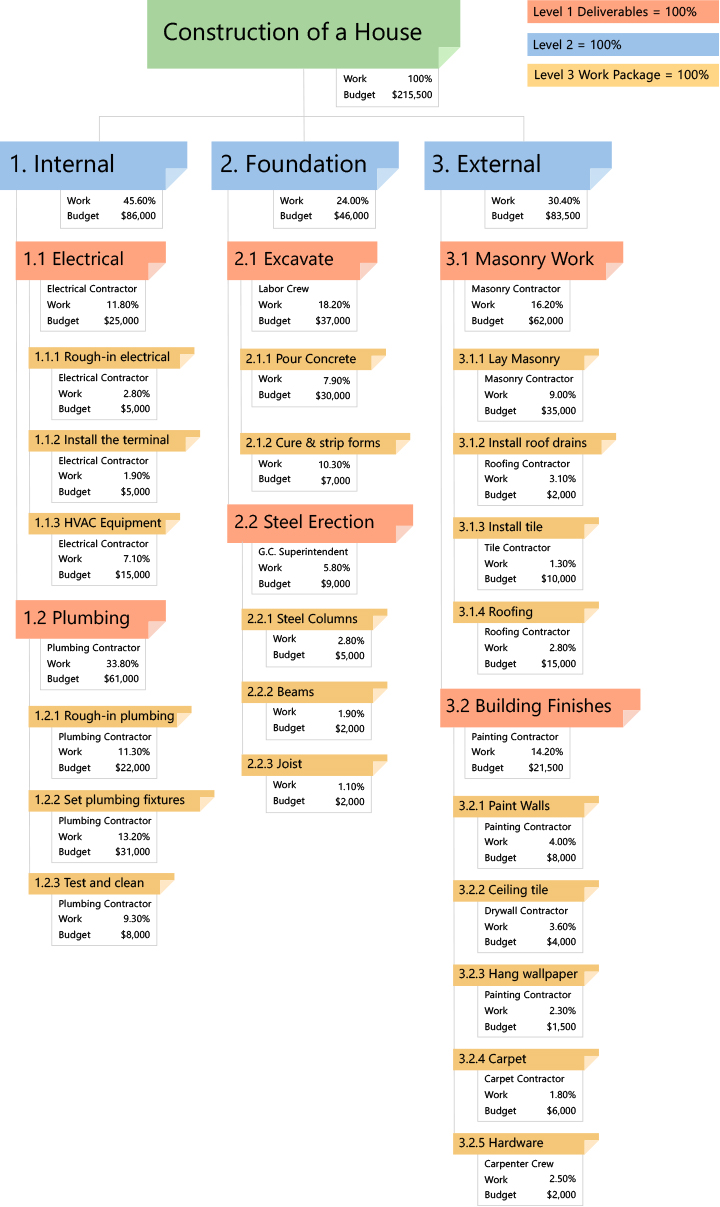This website uses cookies to improve user experience.

➔Free 30-day WBS Software Trial
The first question that someone should ask is why use a Work Breakdown Structure (WBS) at all. The work breakdown structure approach allows us to visually see the work that is needed in order to complete a project. The bottom line is by using a work breakdown structure it reduces the number of surprises and improves the ability to better estimate future projects.
According to the Project Management Body of Knowledge (PMBOK®), and the Practice Standard for Work Breakdown Structures – Second Edition from the Project Management Institute (PMI), the work breakdown structure can be used to effectively decompose the project scope, to improve estimating, to better control the project execution and to more accurately verify project completion. In addition, using a work breakdown structure approach summarizes project information to improve the opportunity for use of historical information, which, can aid in both speed and accuracy of future projects. The work breakdown structure is a repeatable process that can be used as a template for future projects.

Figure 1. Work Breakdown Structure
First, let's start with some basics: The PMBOK® describes the work breakdown structure as "a deliverable-oriented hierarchical decomposition of the work to be executed by the team". This is a way of describing the work so that the team knows exactly what work is needed in order to meet the goals of the project. In many cases, a work breakdown structure is the first transition of organizational goals into real work that people can actually perform. It helps to provide clarity of the scope for the project and "breaks down" the scope into whole work units.
A work breakdown structure is deliverable-oriented. So what is a deliverable? In a word, it can best be described as a noun. What is the difference between "write xyz specifications" and "xyz specifications"? One describes the end product and the other describes a single step to produce it. The end product is described as a noun without a verb. A deliverable can be delegated to a team or leader who can then be responsible for the work product and complete work should be returned when complete. A work breakdown structure is complete when all of the deliverables necessary to obtain the project goals are identified.
A work breakdown structure is a hierarchy. That means that deliverables can be further decomposed into parent and child relationships. In this case "xyz specification" may be further decomposed into "xyz functional specifications" and "xyz performance specifications". It is important that if decomposing the deliverable that the lower child decomposition represents 100% of the parent. This is similar to how we learned to outline our writing in our freshman English class. We can continue decomposing the deliverables until we feel comfortable that we have defined in a way that we can effectively manage and control the project.
Simply put the work breakdown structure technique divides projects into smaller more manageable chunks that can be more easily estimated and controlled. It gives a black and white version of the work effort needed and almost as important if the work is not in the work breakdown structure it is not a part of the project. The work should be decomposed until it is clear to teams performing the work. This provides a clear line of sight between the work and the goals for the project.
The work breakdown structure technique is described in the Project Scope Management section of the PMBOK and further elaborated in the Practice Standard for Work Breakdown Structures – Second Edition. A scope definition is necessary to decide what all should and should not be covered with in the project. When complete, the work breakdown structure lowest level components called "work packages" can be delegated to teams for further development and estimating and a work breakdown structure dictionary can be developed. In this way, project responsibilities can easily be distributed and committed to. This information can then be placed into a scheduling tool. In addition, the work packages can be used to create a project baseline that assures all the work can be evaluated for completeness.
A work breakdown structure is typically presented in the form of an organization chart-like structure. It can be presented as a list, idea map or outline form as well. The key is to put it in a form that can most easily be used by both the team members and organizational leaders with the tools that your company uses most easily.
Since a work breakdown structure is displayed visually and contains summary information, it is easy to share across a team and with managers in an organization. Even on larger projects, the WBS can fit on a page or two. This allows the teams to more easily inspect the results and make adjustments. This view of the information can be used as a template for future projects. If you apply the WBS methodology in the PMBOK , future projects can leverage the work. Using this technique will improve work definition and speed up the planning process.
When you manage similar projects, the work breakdown structure gets better with every project and can become the basis for improved delivery management. For unique projects, the work breakdown structure can aid the team in making sure that deliverables and work packages are complete before involving more people in the planning process. Since it allows work to be distributed, multiple teams can be involved in planning simultaneously and the planning team has greater control over the planning process.
After using this approach, you will never do another project without it. The speed and control that can be gained over planning and execution will pay for itself on the first project. The second project can now use this historical information to get a leg up and a fast start. The deliverables oriented approach also allows for greater stakeholder engagement and easier reporting.
Author: Mark Swiderski
https://www.praxilient.com